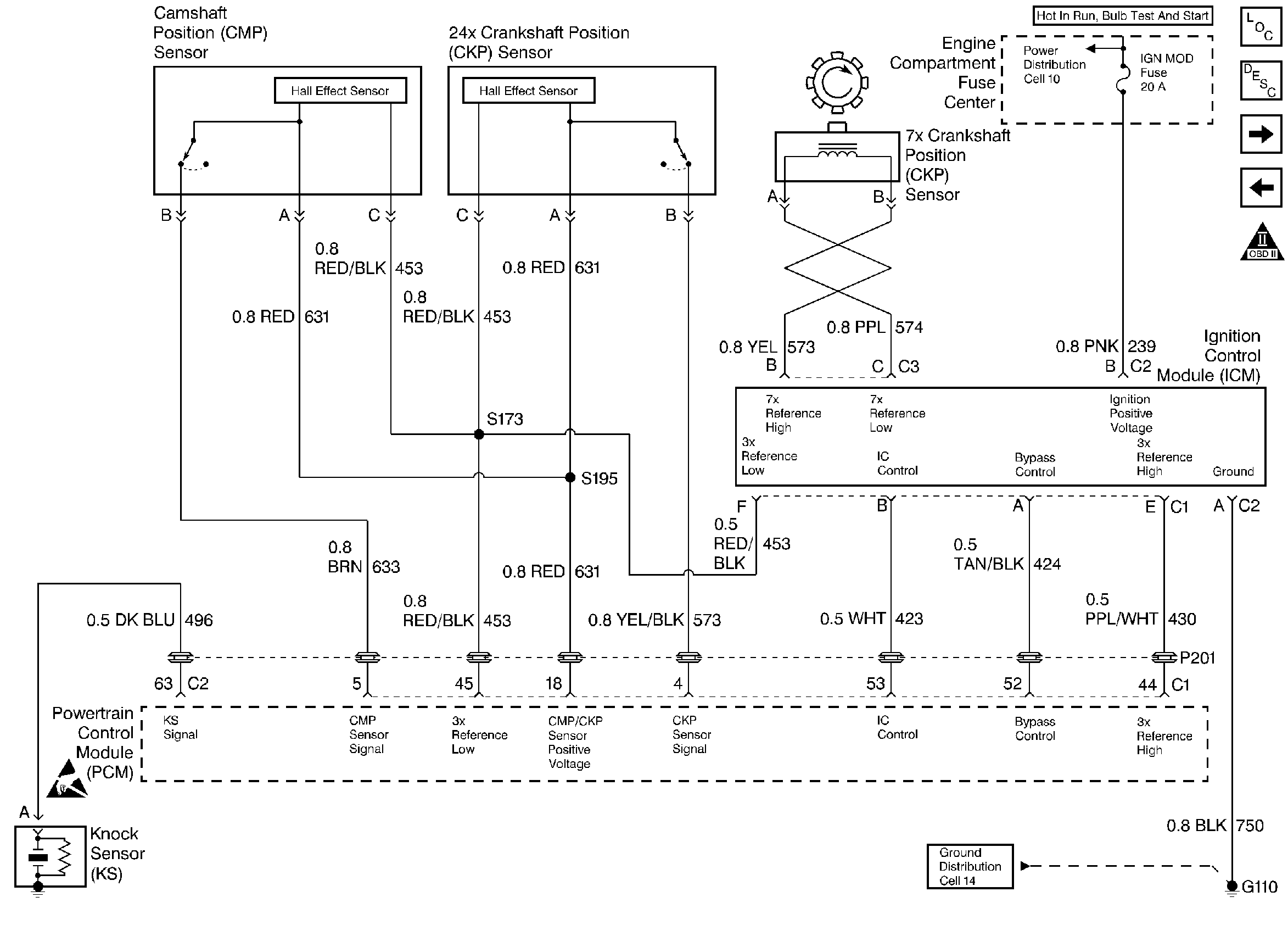Refer to
Knock Sensor, Camshaft Position Sensor, Crankshaft Position Sensor,
Ignition Control Module

.
Circuit Description
The 24X reference signal is used to improve idle spark control at low engine speeds. The PCM uses the 24X reference signal to calculate engine rpm and crankshaft position at engine speeds below 1200 rpm. The PCM constantly monitors the number of pulses on the 24X reference circuit and compares the number of 24X reference pulses to the number of 3 X reference pulses and CAM signal pulses being received. If the PCM receives an incorrect number of pulses on the 24X reference circuit, DTC P0336 will set and the PCM will use the 3X reference signal circuit for fuel and ignition control. The engine will continue to start and run using the 3X reference and CAM signals only.
Conditions for Setting the DTC
| • | The engine is running (3X reference pulses are being received). |
| • | The ratio of 24X reference pulses to 3X reference pulses received by the PCM is incorrect. |
| • | Above conditions for 450 occurrences. |
Action Taken When the DTC Sets
| • | The PCM will illuminate the malfunction indicator lamp (MIL) during the second consecuitive trip in which the diagnostic has been run and failed. |
| • | If equipped with traction control, the PCM will command the EBTCM via the serial data circuit to turn OFF traction control, and the EBTCM will illuminate the TRACTION OFF lamp. |
| • | The PCM will store conditions which were present when the DTC set as Freeze Frame and Failure Records data. |
Conditions for Clearing the MIL/DTC
| • | The PCM will turn OFF the MIL during the third consecutive trip in which the diagnostic has been run and passed. |
| • | The History DTC will clear after 40 consecutive warm-up cycles have occurred without a malfunction. |
| • | The DTC can be cleared by using the scan tool. |
Diagnostic Aids
DTC P0336 can be caused by secondary components leaking high voltage into the ignition module. Check for the following conditions:
| • | Incorrect harness routing near secondary ignition components. |
| • | Ignition coil arcing to wiring harness or Ignition Control Module (check ignition coils for cracks, carbon tracking, or other signs of damage). |
| • | Secondary ignition wire(s) arcing to wiring harness. |
An intermittent may be caused by a poor connection, rubbed through wire insulation or a wire broken inside the insulation. Check for:
| • | Poor connection. Inspect the PCM harness and connectors for improper mating, broken locks, improperly formed or damaged terminals, and poor terminal to wire connection. |
| • | Damaged harness. Inspect the wiring harness for damage. If the harness appears to be OK, disconnect the PCM, turn the ignition on and observe a voltmeter connected to the 24X reference circuit at the PCM harness connector while moving connectors and wiring harnesses related to the 24X Crankshaft Position Sensor and Camshaft Position Sensor. The 24X and Camshaft Position sensors share the same sensor feed from the PCM. A change in voltage will indicate the location of the fault. |
It also may be helpful to monitor the 24X rpm on the scan tool, to look for erratic rpm fluctuations.
Reviewing the Fail Records vehicle mileage since the diagnostic test last failed may help determine how often the condition that caused the DTC to be set occurs. This may assist in diagnosing the condition.
Test Description
Number(s) below refer to the step number(s) on the Diagnostic Table.
Step | Action | Value(s) | Yes | No | ||||||
|---|---|---|---|---|---|---|---|---|---|---|
1 | Was the Powertrain On-Board Diagnostic (OBD) System Check performed? | -- | Go to Powertrain OBD System Check | |||||||
2 | Attempt to start the engine. Does engine start? | -- | Go To Engine Cranks but Will Not Run | |||||||
3 |
Is DTC P0336 set? | -- | Go to Diagnostic Aids | |||||||
4 | With DVM Check for voltage at Crankshaft Position and Camshaft Postion Sensor Feed circuit. Does the DVM display a voltage near the specified value? | B+ | ||||||||
5 | Disconnect PCM.
Does the DVM display a voltage near the specified value? | B+ | ||||||||
6 | Check for the following circuit conditions:
If a problem is found, repair as necessary. Refer to Repair Procedures in Electrical Diagnosis. Was a problem found? | -- | ||||||||
7 | Check connections at the PCM and replace terminals if necessary (refer to Repair Procedures in Electrical Diagnosis). Did any terminals require replacement? | -- | ||||||||
8 | Check connections at the Crankshaft Position Sensor at Reference Signal circuit and replace terminals if necessary. Refer to Repair Procedures in Electrical Diagnosis. Did any terminals require replacement? | -- | ||||||||
9 |
Was a problem found? | -- | ||||||||
10 |
Does DVM indicate continuity? | 0 ohms | ||||||||
11 | Check for the following circuit conditions:
If a problem is found, repair as necessary (refer to Repair Procedures in Electrical Diagnosis). Was a problem found? | -- | ||||||||
12 |
Is test light On? | -- | ||||||||
13 | Replace 24X crankshaft Position Sensor. Is action complete? | -- | -- | |||||||
Replace the PCM. Important: Replacement PCM must be programmed. Refer to PCM Replacement/Procedure? Is the action complete? | -- | -- | ||||||||
15 |
Does scan tool indicate DTC P0336 failed this ign? | -- | Repair Complete |
